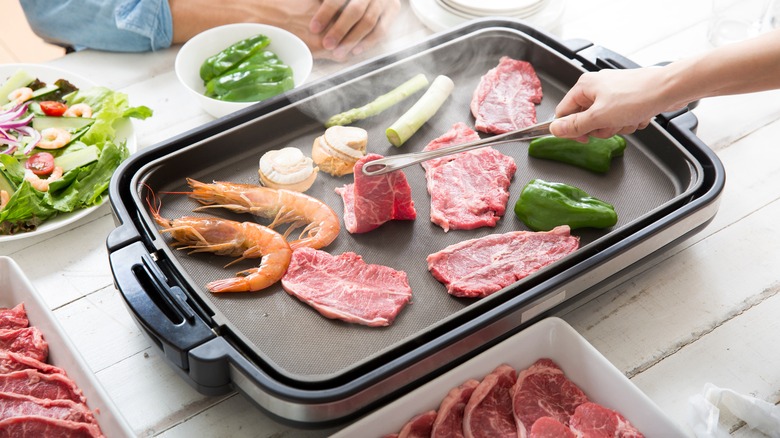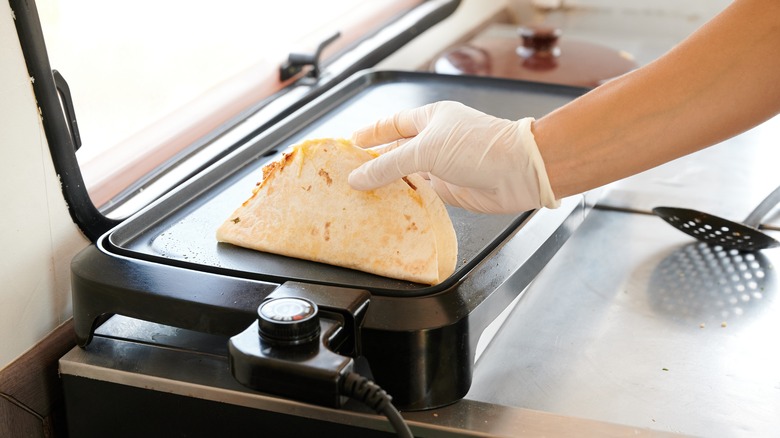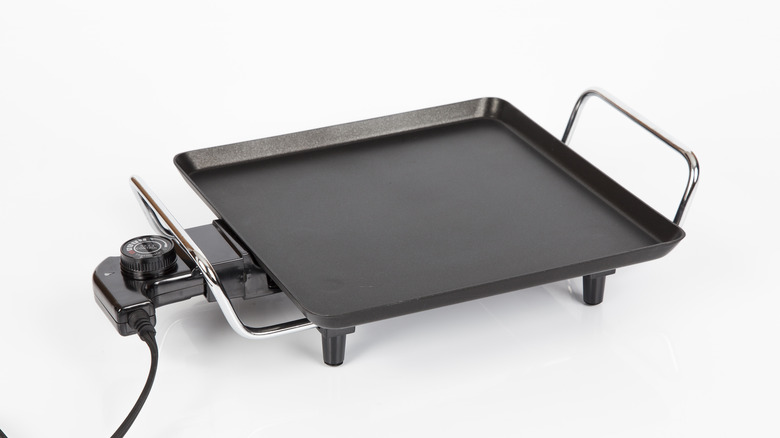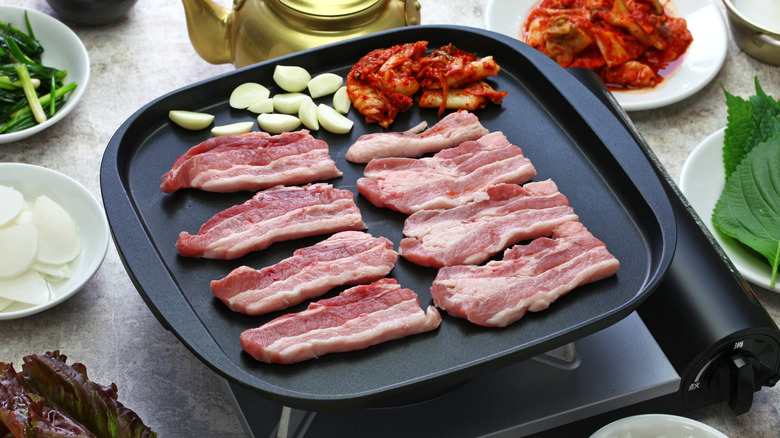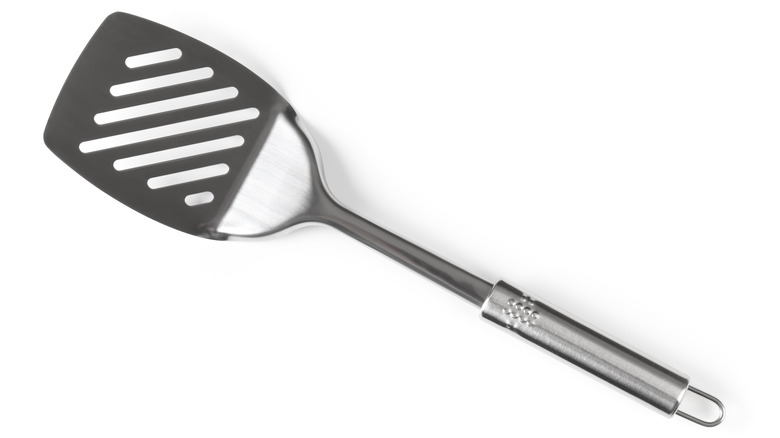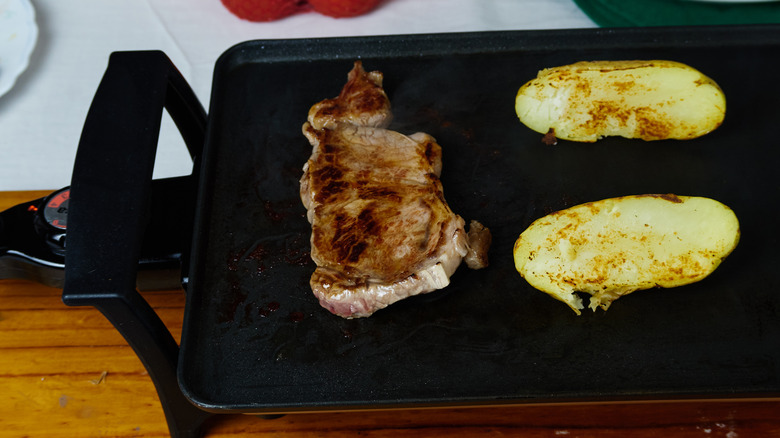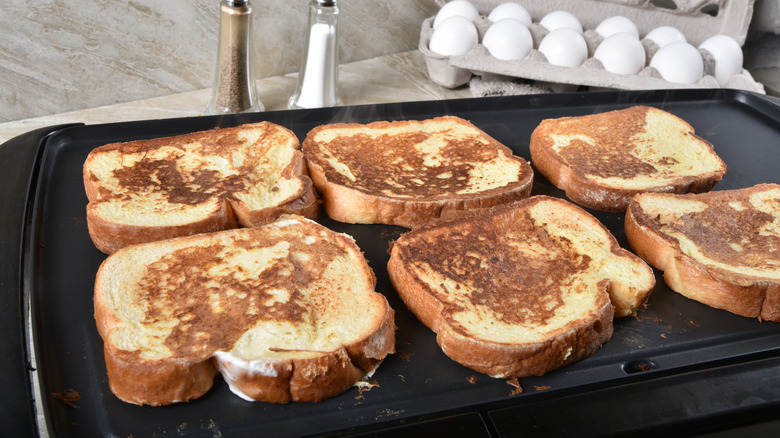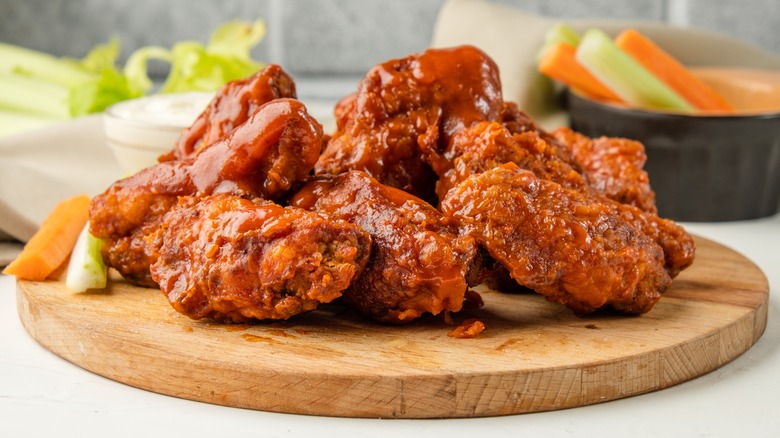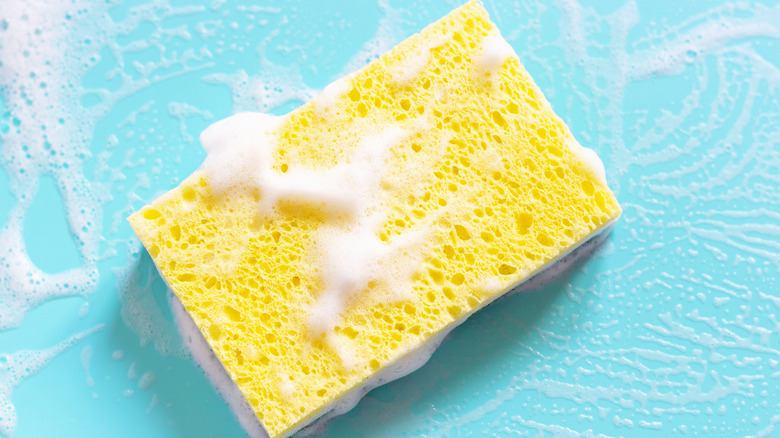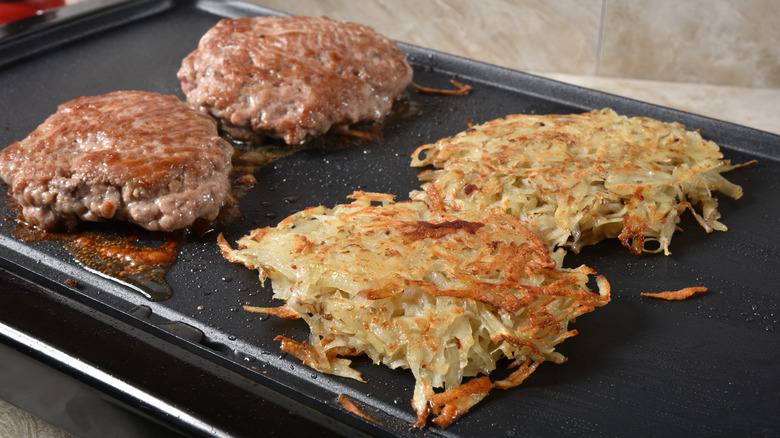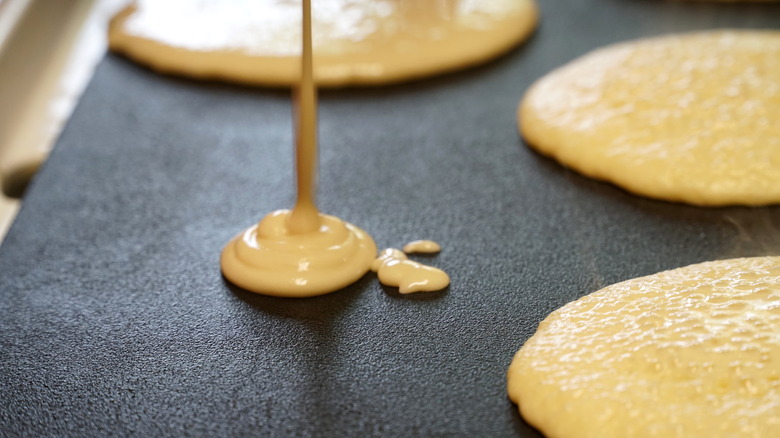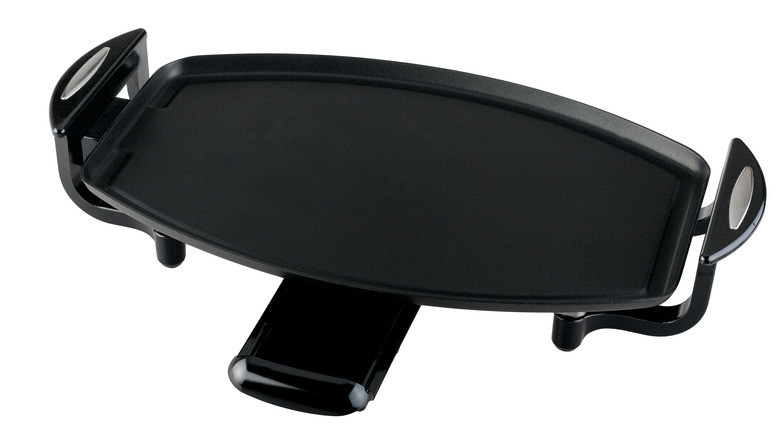12 Mistakes Everyone Makes When Cooking On An Electric Griddle
These days, there's a plug-in appliance for all of your kitchen needs — but few are as easy to use as an electric griddle. Electric griddles allow you to make restaurant-quality food without the need for a huge, unwieldy, gas-powered range. These machines heat their flat-top surface directly from a power socket, and a surprising amount of food can be fit on their snug designs. Electric griddles are particularly useful when you want to cook food that isn't swimming in fat, thanks to their ability to drain grease away into an embedded well or drip tray. As many electric griddles are coated with a nonstick surface, you also don't have to use much fat in the first place or worry about your food catching on the metal.
Despite their simple design, however, cooking with an electric griddle isn't a walk in the park. These appliances can be slightly more unpredictable than cooking on your regular stove, and many foods will require a different temperature than you might be used to in order to cook correctly. Some foods may also be unsuitable for an electric griddle in the first place, leading to a disappointing meal. You're in luck, though: All of these mistakes, and more, can be easily avoided.
1. Starting to cook before it's heated up
When electric griddles have had time to heat up fully, they can produce a lot of heat. The challenge, though, is allowing them to heat up enough in the first place. Electric griddles are heated via an electric coil underneath the cooking plate, and depending on your model, this can take way longer to heat up than if you were cooking in a pan on a gas stove. Too many people, however, try to place their food on an electric griddle before it's hot enough, and this can result in their items being unevenly cooked or soggy.
This is a particular issue if you're cooking items like eggs or pancakes on your electric griddle. Because these foods are runny and require immediate high heat to firm up, you run the risk of them ending up misshapen, or worse, dripping off your griddle and into its well. The best thing to do is plan ahead and give your griddle enough time to heat up. Some models can take around 10 to 15 minutes to heat through fully. This is often indicated by a pilot light switching off or another notification on your machine. You can use the time it takes to heat up to prepare your food.
2. Underestimating how hot they can get
Just because electric griddles get their energy from a power socket doesn't mean they're not powerful. It's common to completely underestimate how fierce your electric griddle can be, leading to a host of issues. Some widely available electric griddles can get up to 450 degrees Fahrenheit, which is in the neighborhood of the heat emitted by the higher settings on a gas stove. It can also be difficult to know exactly how hot your electric griddle can get, as some models' heat settings may be indicated by single-digit numbers (e.g. one being the lowest and nine being the highest) instead of specific temperatures.
This can be tricky for a few reasons. The first is safety-related and can lead to mishandling your griddle without knowing how hot it truly is, leading to potential burns. The second is that it presents problems for your recipes, as a griddle's ultra-high heat may lead to you burning your food. If you're working with a new griddle, you should take the time to get to know it, figuring out exactly how hot each temperature setting gets. Your griddle's instruction manual may also have information about settings and how they correspond to temperatures.
3. Forgetting about your hot spots
Hot spots are a huge issue when it comes to griddles, and electric griddles aren't immune from this. Your appliance will have certain areas that get hotter than others, and these are determined by a few factors. One of these is how big your electric griddle is, and thus how many electric coils it has, with larger machines generally giving a more consistent temperature thanks to having multiple heating elements. If your electric griddle has a particularly thin heating plate, this may also cause it to have more hot spots, as those made from thicker materials will retain heat more effectively.
In some cases, these hot spots may be largely inconsequential, but they can sometimes alter how your food cooks pretty drastically. Certain food items can end up overcooked, while others may take way longer than usual, and this inconsistency can lead to your meal's components being ready at different times. Ultimately, the only way to handle hot spots is to get to know where they are on your appliance. Once you've figured this out, you can arrange your food items accordingly. Try to place items that will need longer cooking times or more browning on the hot spots, with your other items taking up the slightly cooler spaces on the griddle.
4. Using the wrong cookware
Your electric griddle may be sturdy, but it's not invincible — and a surefire way to reduce its life span is to use the wrong cookware. Metal spatulas or stainless steel forks or spoons are your electric griddle's worst enemy because it likely has a nonstick surface. When you use metal utensils on a nonstick surface, they scratch the coating, which eventually causes it to peel away. This takes away its nonstick quality pretty quickly and leaves your food adhered to your griddle.
Even if your griddle isn't nonstick, using metal utensils can still scratch it and make things look pretty ugly. You should instead opt for softer cookware. Silicone spatulas are a great option for electric griddles, thanks to their pliable nature and heat-resistant qualities (although you should make sure that your silicone is built to withstand high temperatures, as some plastic utensils can melt). Wooden utensils are also a great option, as well as nylon. If you're using wooden cookware, though, just make sure that you're maintaining it properly, as over time it can crack. This can expose potential corners or sharp edges that may wear away at nonstick surfaces.
5. Not using your tilt function
Certain electric griddles have one function up their sleeve that many other appliances don't: the tilt function. It's easy to ignore this feature and leave your griddle level, which can essentially ruin your food. The tilt function, as its name suggests, allows you to tilt the angle of your griddle slightly, creating a slightly downward slope into the machine's drip tray or well. This helps to drain fat or moisture away from whatever you're cooking, stopping your food from getting greasy and allowing it to brown properly.
Crucially, however, there is a flip side to this mistake, which is another mistake entirely: leaving your griddle tilted when you cook. This is less of an issue with greasy, solid items and more of a problem for liquid-based foods that require a flat surface to cook properly. After you've cooked your food and turned your griddle off, you should always make sure that you've reset it to its original position. Do this before you put your machine away, as you may not remember that it's tilted the next time you come to use it again.
6. Cooking your food on the wrong temperature setting
Electric griddles may have a simple design, but that doesn't mean all food cooks in the same way on them. Like any other kitchen appliance, you have to be careful with the temperature you use so that you don't overcook or undercook your food. Unfortunately, a lot of people simply whack their machine up to "high" and start cracking their eggs onto the hot plate, only to find that they burn nearly instantly.
There's a wide range of ideal temperatures for different types of food on a griddle, and some might surprise you. Meat items, for example, should generally be cooked at a mid-range temperature of around 325 to 375 degrees Fahrenheit. While you might think that going hotter is better, the medium temperature allows your food to cook evenly without the meat burning on the outside. Waffles, on the other hand, should be started at a high heat before reducing the temperature to get that crispy exterior while keeping it fluffy on the inside. If you're in any doubt about what temperature you should be cooking at, many instruction manuals have a handy guide to the best heat for different food items.
7. Trying to cook bulky food
Your electric griddle can handle a lot of things, but cooking bulky food isn't one of them. Bulky items suffer on an electric griddle because its flat surface just isn't as good at distributing heat through the entirety of the food, which can leave it poorly cooked or still raw in the middle. This is especially true of items like chicken wings, legs, or thighs, and hot dogs or other sausages. Irregularly shaped chicken pieces simply may not make enough contact with the griddle to cook evenly, whereas round food items require near-constant moving around to make sure they're browning properly on all sides.
Hot dogs and sausages also suffer from another issue with griddles, which is that the flat surface enables them to roll around. If you're cooking multiple different items at the same time, this can cause your dogs to clatter into them. For bulkier items, we would always recommend using a cooking method that delivers wrap-around heat to ensure even cooking. If you like, you can always use your electric griddle to sear any bulkier items, finishing them off with a nice char.
8. Forgetting to clean it after you cook
Let's face it: Cleaning anything after you've just had a delicious meal isn't exactly fun. (There's a reason why eating out is so popular, after all.) Forgetting to do so with your electric griddle, however, is a big mistake. Cleaning your griddle thoroughly after each use prevents it from building up food waste and grime, which can lead to it retaining smells or flavoring the next thing you cook. It also helps to keep your device in working order, stopping any grime or grease from building up in it.
When cleaning an electric griddle, it's important not to use too much moisture, so water doesn't drip down into the machine and potentially cause it to malfunction. Wipe the griddle surface clean with a damp, soapy cloth after scraping away any leftover bits of food. Follow this up with a damp cloth without any soap to get rid of the residue and dry everything off. Make sure that you also clean out any wells or drip trays each time so that no excess fat remains on the machine and goes rancid. Now and again, you should also perform a deep clean, getting into any corners of the machine, cleaning its underside and sides, and getting into the gaps around any buttons.
9. Only cooking one food item at a time
Too many people simply don't understand the potential of their electric griddle. While the rest of their meal cooks away on the stove, they'll use their griddle for one single food item, like pancakes, heating the entire machine to take up only a portion of its space. Importantly, though, griddles can be used to make multiple food items at once, with some models specifically designed to be used to prepare full meals.
So, next time you're making a breakfast of bacon, eggs, pancakes, and grilled tomatoes, remember that every one of those things can be placed on your griddle at once, provided that you have the space. If you're whipping up some Philly cheesesteaks, you can cook the meat on one side of the griddle, melt your cheese onto it in the last few minutes, and toast your rolls on the other side. You can even make meals that require multiple different ingredients cooked at different stages, like shrimp fried rice. Begin by cooking your shrimp and scrambled eggs before removing them, placing them to one side, and cooking your vegetables. Add your rice and proteins back in, fry it all together on the flat top, and you're good to go.
10. Forgetting to use your lid
Electric griddles don't always come with lids, but those that do often see the lids stashed away in the cupboard, never to be used again. Do this, though, and you miss out on the ability to cook your food items from the top as well as the bottom, by trapping the heat from your flat top.
This is ideal when you're making certain styles of pancakes or waffles, with the lid helping to steam them gently from above, giving them a fluffy, tender consistency. It can also be great if you're making fried eggs and want them to cook on the top without having to flip them, risking breaking the yolk. If making a grilled cheese, putting on the lid will help the cheese melt in the middle more effectively.
Additionally, your lid can serve a valuable storage function. By placing the lid on your griddle before you put it away, you can stop dust from accumulating on its surface. Using the lid when storing your griddle can also prevent it from becoming scratched, which is easily done if you're stacking a load of pans on the flat top, thereby deteriorating its nonstick qualities.
11. Cooking on a scratched griddle
Unless you're very, very careful, sooner or later, your griddle will probably become scratched. When this happens, it's probably time to buy a new one. While you might be able to get away with cooking on a griddle with ultra-small scratches, especially if you avoid placing food near them, once your nonstick surface starts scratching, it can then begin to flake away. These nonstick flakes can then end up in your food. It should be noted that nonstick surfaces like Teflon are non-toxic, so ingesting them won't do any harm. However, it's hardly what you want to be eating, right?
Importantly, a scratched griddle and flaking coating means that your nonstick griddle may soon not be nonstick at all. Once the coating's gone, your food will likely need increasing amounts of fat to stop it from sticking to the surface, and in griddles, this can be an issue, as the fat tends to spread out, becoming hard to contain. As a general rule of thumb, nonstick pans need replacing every five years or so, and electric griddles have a similar life span, although some may last for as long as 20 years. A lot of this depends on how often you use your appliance, though.
12. Not giving it time to cool down
Electric griddles can take a while to heat up, and things aren't any different the other way around. Some electric griddles can take around 15 minutes to partially cool, and even longer to cool completely, significantly longer than a lot of other cookware. This is because the heating component is internal, so you need to not only wait for the griddle plate to cool down but the electric coils that warm them up to do so as well. Things can take even longer if your griddle plate is especially thick, as this will allow it to hold onto heat even better.
Giving your electric griddle time to cool down keeps you safe when handling it so that you don't try and put it away while it's still scorching. It also stops your electric griddle from damaging other items with heat, if placed in storage before it's been allowed to cool. You should also always give your griddle time to cool down before you clean it, as doing so when it's still hot can be hazardous. If in doubt, the best thing to do is give it more time, instead of less.
